I am going to be analysing the first 15 minutes of the film 27 Dresses. I chose this film to analyse as i feel that it has a strong link to the film that my group is planning to create and therefore the shots and edits used throughout the opening to this film could be similar to the opening of the film my group creates, as we could mould some of the effects used in this film to make our film match the genre that we have chosen for it.
The music in the opening of 27 Dresses is especially significant for a number of reasons. Firstly, the film uses music to highlight the mood of the scene and the storyline. In the very beginning of the film we see the main character when she was 8 years old as a bridesmaid at a wedding. During this section of the film, there is a number of non-diegetic sounds such as the music in the background. The music is used here to highlight to the audience that this is a romantic and happy occassion which has stuck in the head of the main character as one of the focal points in her life, the film has used music in this scene which not only portrays his message but matches the emotions that t makes the audience feel. It gives the audience the chance to relate to the characters as everbody has a moment in thier life which means a lot to them and have shaped the majority of thier lives ever scince. This scene is designed to make the audience think and laugh at thier own memory. Paired with this romantic, major key music is the voice over of the main character. The voice over is also one of the main components of this scene as it allows the audience to recognise that this is not present day, this is if they didnt understand that when the date was shown on screen that it was a flashback. The voice over also highlights to the audience the importance of the moment we are viewing in the main characters life and therefore makes the audience feel priveledged that they get to be part of this characters memory, this immidiatley forms a connection of emotions between the main character and the audience.The diegetic sounds in this scene is to simply add realism to the scene and to make it more personal to the audience allowing them to make a connection and a judgement of the characters they are watching.
The music changes continuously throughout the rest of the opening 15 minutes only stopping temporarily for the occassional piece of dialogue. In the centre of the 15 minutes, the film goes through a number of shots showing the different weddings that the main character is attending. The music changes dependant on who's wedding she is currently at, for example at the indian wedding, indian music is playing in the background. This music is non-diegetic as it played duing the receptions of each of the weddings. The music then changes again to a faster paced dance music as the film goes through a montage of repetitive dance sequences at each of the weddings. The music here is non-diegetic as it not the music to the well known dances that the main character is doing, also we know it is non-diegetic as it doesn't change dependent on which wedding she is currently at, this is because the main character is doing the same thing at both of the weddings and therefore the music is highlighting to the audience the motions the main character has to go through, highlighting how much she enjoys it.
The music only stops at the end of this scene when the focus is totally on the main character of the film, highlighting to the audience that all the attention is on her and nobody else.
Later on the music changes once more as she is introduced to the main male character and he takes care of her, this highlights to the audience that this character is important and will most probably be a vital part of the story throughout the majority of the rest of the film, and become a love interest near the end.
I the final minutes of the section i have analysed the music changes to show the male characters thoughts about the woman when he finds her log book in the back of the taxi. This confirms to the audience thier thoughts about the rest of the film, that he will be there the whole way through and will become a love interest.
The editing in the opening 15 minutes of the film is the other main aspect to emphasizing the genre and storyline at the opening of the film.
In the beginning of the film we see a number of different cross fades as the young girl helps the bride fix her dress and to show the change of location from the isle to the toilets where the bride is waiting and panicking.
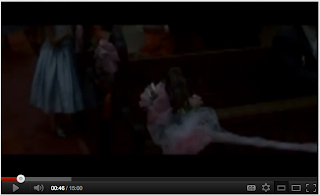 |
| Cross fade at the beginning of the film |
The fade to black that we see at the end of this opening section is to higlight the lengthier pass of time and location. After the images fade back into view we are introduced to same main character although later on in her life. The fade to black was to highlight the end of the flashback and the beginning of the real time film.
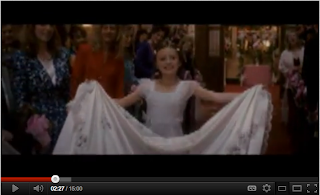 |
| This shows a fade to black at the end of the main opening section |
There is a section before the main character attends the weddings when the editing is fast paced. This is used to highlight to the audience the need to rush that the main character has the frantic panic that she has when the fast paced editing continues into the wedding scene. Also in the same section we get a number of cuts, this shows another passage of time but is also used to speed up the editing and emphasize the panic that the main character is feeling when she is rushing between the two weddings. these cuts are used in the film when the main character is thinking of other people and not herself, when the focus is on her the editing is slow with hardly any cuts to highlight tha the focus is on her and nobody else.
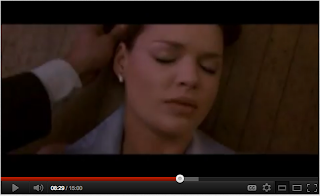 |
| This shows the end of the fade to black when the main character is knocked unconscious |
When the character is knocked unconscious we see a fade to black this is usually used to show a passage of time but in this film i think it is used as a first person view as when we come out of the fade we are still seeing through the eyes of the main character.
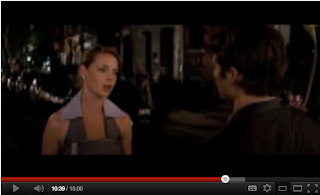 |
| This screenshot shows the beginning of the shot-reverse shot sequence between the main characters |
The last piece of editing in the section I analysed was a shot reverse shot obeying the 180 degree rule when the main characters are conversing. This is used to highlight which character holds the most power. In this scene i think that both of the characters have equal power to highlight to the audience the storyline of the rest of the film, the equal power emphasizes that the two characters are going to grow closer rather than further apart.
In the last couple of the minutes the film changes from the opening introductory scene to the main body of the film, meaning that the reasons for shots and music changes. In the opening scene the shots are used to higlight the genre of the film and the potential storyline.
I think that there is a lot of things in the opening of this film that we could take and adapt to fit our film, these include the music being in a number of shots, highlighting mood and environment and the fades and cross fades that highlight passages of time. I also think that we could use the flashback component to the advantage of the mysterious side of our film highlighting that not all is well.
Overall i think that analysing this section of film has helped me come up with ideas for my own film.
Some of the shots that are used throughout the beginning of the film are:
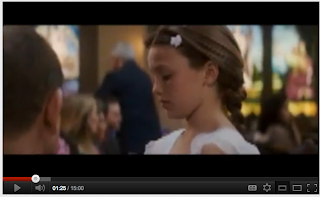 |
| This shows one of the close ups used in the beginning of the film. |
Close up: A close up is used in the film to highlight people of importance and to emphasise the emotions of certain characters.
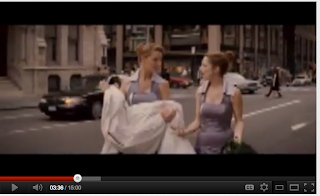 |
| This screenshot shows a medium close up in the film. |
Medium Close Up: In this section of the film, this shot is used to underline the surroundings of the characters whilst also emphasising the emotions and actions of the characters in the scene.
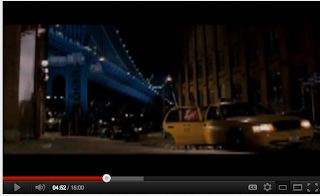 |
| This shows one of the long shots used in the opening of the film |
Long Shot: This is used in the film in a number of places to highlight to the audience the locations of the characters whilst also being able to see the clothing and body language of the character that is in the scene.
There a number of other different techniques that are used in the opening section of the film, however, some of them i don't feel are appropriate for the type of film that we want to create and have been used in the opening of this film for the same reasons as the shots i have pointed out above.
This is the link for the film, it has been flipped from the original film for copyright reasons but the film is still visible without being hinderd because of this.
http://www.youtube.com/watch?v=1OkLNOCUfLY .





















